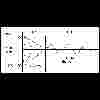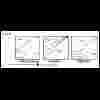Gigasampler Tutorial: Lesson 4
Tascam
Gigastudio home
In this lesson we will see the functions of the case properties menu EG3/LFO and Filter windows.
In the left part of EG3/LFO section we find the parameters for setting up a modulation of the sample pitch during the attack, whose duration can be set up in the attack time box: the sample will be initially played "detuned" of the amount specified (in cents of tone) in "+ / - depth", and will go to the original tuning in the time set up in "attack time". Once the modulation of the attack pitch is finished (but note that it can also not be present!), it begins the LFO (low frequency oscillator), whose parameters are specified in the right section of the window case properties. It is possible to set up the LFO frequency modulation in the frequency box, and the amplitude of the modulation (in cents of tone) in two different ways: internal or external. In the first case the amplitude is fixed to the value specified in "internal depth": the sample pitch is varied constantly, following a sinus wave of the set frequency; we cannot alter this modulation form the outside. In the other case we can set up the amplitude of the modulation by means of modwheel or the aftertouch: in the "controller depth" box we specify the maximum pitch modulation value, and this be then varied from minimum (zero) to the selected maximum with the specified controller. The way of operation of the LFO is chosen in the window below: internal, external (modwheel or aftertouch) or a combination of the two. The operation of EG3/LFO is summarized in figure 1.
The file "demo Eg3-LFO.gig" illustrates the concepts explained above; the notes are set up like follow (open the .gig tutorial and the case-properties window -> EG3/LFO in order to see the settings, choosing in the region map the note examined): E4: the sample as it "sounds" normally, "as recorded" F4: as soon as the note is played, the sample is tuned up 500 cents, and returns to the normal tuning (F4) in an time equal to 2 seconds. G4: since it is not possible to control in real-time the attack time of the EG3 (therefore as detuning and many other parameters of gigasampler, for example those in EG1, EG2..) I have used the following trick: I have created a dimension with 4 split (you see in fact the 4 cases in the zone "dimensions") and I have assigned it to controller 1 (mod wheel). To each of these zones I have attributed the same sample, with exactly the same settings, except for the EG3 attack time. In this way it is possible to control, with the modwheel, the "falling time" of the pitch from 0 to 4 seconds. The initial pitch is set up one octave up. It is important to note that, instead of changing the EG3 attack time in every zone, I could have changed detuning (+ / - depth cents) (or whichever other parameter your fantasy suggests) and therefore control, in real time, the initial pitch of the sample: try to play various times the note by varying the position of the modwheel. We will return later on these tricks, with a large series of examples.
A4: here we have a LFO example: the vibrato is of 2 semitones
(200 cents) at a frequency of 5 cycles per second (5 Hz). The vibrato is controlled
by gigasampler (internal).
B4: here the vibrato speed is again 5 Hz, but this time its depth is controlled
externally by the user with the modwheel.
C5: here I have arranged both the EG3 and the LFO to 2 semitones.
D5: in this case the LFO is set internally to 2 semitones, but through the
modwheel it is possible to obtain an heavier vibrato, up to 4 semitones.
The filter section of Gigasampler offers several expressive capabilities : it is possible to control the filter in several dynamic ways both internally and externally. Even if this is not the appropriate place for talking about filters, we remember you, very simply, that a "filter" acts on the spectral components of a sample, by means of increasing or decreasing their intensity. The first source of filter modulation is the envelope curve set up in EG2. To this modulation we can superimpose the velocity of the note played (filter controlled by the velocity) or of a controller (typically modwheel or breath controller). We can moreover act on the filter width (Q) and on the cutoff. Initially, it is necessary to choose the type of filter applied to the sample: we have at our disposition the classics low-pass, band pass, high-pass and band reject filters. The filter can be controlled externally from a controller, choosing it in the appropriate menu. Through this controller we can act on the cutoff frequency. The maximum cutoff frequency is set up in the case "cutoff frequency", but only if in "midi controller" it is selected "none". The frequency of minimum cutoff can instead be set up once we chose a midi controller, and at this point it will appear, on the right, the voice "min cutoff". The filter, at this point, is set in order to operate between the two frequencies min-max cutoff. The filter responds also to the intensity at which we play the note (the velocity); "vel. curve" and "velocity dynamic range" determine the answer of the filter to the velocity of the note. Such curves are displayed in figure 2. It exists another option "vel. scale", which appears when in "midi controller" it is selected "none". In this way we can scale the currently selected velocity curve in order to specify a much larger number of filters velocity responses. Values below 20 will cause the filter to "open more slowly", darkening the response. Values above 20 will make the filter to "open more quickly". We can set up the resonance frequency (resonance) and finally we can force the Q to answer dynamically to the changes of the cutoff by checking the case "dynamic".
The effective cutoff frequency is therefore the sum of various factors: EG2, external controller, velocity. In the file "demo Filter.gig" I have tried of summarise them in the following way:
G4: the sample as it sounds normally, "as recorded"
A4: here I have added a low pass filter, and the cutoff can be controlled
through the modwheel. When the modwheel value is zero, the filter has a cutoff
set to 20 (min cutoff), while when the modwheel is at his maximum value the
filter does not act more (all-pass filter!).
B4: like for A4, but I have modified the min cutoff. When the modwheel is
at his minimum, the sound feels more "open"
C5: this is an example of how the EG2 envelope (take a look how it is set
up) can be used for modulating the cutoff.
D5: here I have overlapped the EG2 envelope, like in the previous example,
to the external modwheel controller, in order to have a higher degree of freedom.
|
fig.1
|
fig.2
|
 |
 |
Files:
Inferno_G4.wav
Demo Eg3-LFO.gig
Demo Filter.gig
Lesson Index
Back to lesson 3
Continue to lesson 5
You
don't see frames?
Click here!